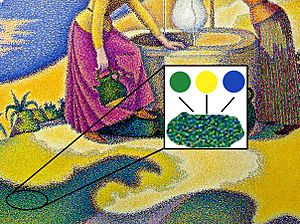Pointillism facts for kids


Pointillism is a special way of painting. Artists use many small, separate dots of pure color to create a picture. Imagine a painting made up of hundreds of tiny dots, mostly red, yellow, blue, and green, with some white. Your eyes and brain then mix these colors together. This makes you see different shades, like orange, purple, pink, or brown, depending on how the dots are placed.
Contents
How Pointillism Started
The artists Georges Seurat and Paul Signac created this painting technique in 1886. Seurat was first an Impressionist painter. Other famous artists like Camille Pissarro and sometimes Vincent van Gogh also used Pointillism in their work. When art critics first saw these paintings, they made fun of them. They called the style "Pointillism" as an insult. But today, the name is still used, and it's no longer seen as an insult.
Painting with Dots
Normally, painters mix their colors on a palette before putting them on the canvas. Pointillist painters do not mix colors at all. They use the pure colors straight from the paint tube. Traditional painters also use many different kinds of brushstrokes and paint textures. Their paintings might have smooth areas, lines, squiggles, or dabs of paint.
In a Pointillist painting, almost every part of the picture is made of tiny dots. Most of these dots are about the same size. Pointillism is usually done with oil paints. This is because oil paints are thick. They do not run into each other when painted on the canvas. This helps keep the dots separate and clear.
Pointillism in Technology
You might not realize it, but Pointillism is used in many modern technologies! Many color printers use a similar idea. They print pictures using tiny dots of four colors: cyan (a type of blue), magenta (a type of red), yellow, and black.
Televisions and computer screens also work in a similar way. They create many different colors by using only tiny red, green, and blue lights. When these tiny lights are close together, your eyes mix them to see a full range of colors.
Gallery
-
A village in Holland, by Paul Baum (1905)
-
Vincent van Gogh, Self Portrait, 1887. This painting uses a Pointillist style.
Related pages
Images for kids
-
Henri-Edmond Cross, L'air du soir, c.1893, Musée d'Orsay
-
Georges Seurat, 1884, Bathers at Asnières, oil on canvas, 201 × 301 cm, National Gallery, London
-
Georges Seurat, 1884–1886, A Sunday Afternoon on the Island of La Grande Jatte, oil on canvas, 207.6 x 308 cm, Art Institute of Chicago
-
Théo van Rysselberghe, 1887, Sailboats and Estuary, oil on canvas, 50.2 x 61 cm, Musée d'Orsay
-
Camille Pissarro, 1888, La Récolte des pommes, oil on canvas, 61 x 74 cm, Dallas Museum of Art
-
Jan Toorop, 1889, Bridge in London, Kröller-Müller Museum
-
Georges Seurat, c.1889-90 Young Woman Powdering Herself, Courtauld Gallery
-
Georges Lemmen, c.1891-92, The Beach at Heist, Musée d'Orsay Paris
-
Théo van Rysselberghe, 1894, Portrait of Irma Sèthe
-
Théo van Rysselberghe, 1899, His wife Maria and daughter Elisabeth
-
Paul Signac, 1901, L'Hirondelle Steamer on the Seine, oil on canvas, National Gallery in Prague
-
Henri-Edmond Cross, 1903-04, Regatta in Venice, oil on canvas, 73.7 x 92.7 cm, Museum of Fine Arts, Houston
-
Robert Delaunay, 1906, Portrait de Metzinger, oil on canvas, 55 x 43 cm
See also
 In Spanish: Puntillismo para niños
In Spanish: Puntillismo para niños




















